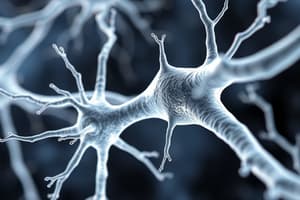Podcast
Questions and Answers
What is the primary function of neurons in the nervous system?
What is the primary function of neurons in the nervous system?
- To transmit electrical signals (correct)
- To regulate body temperature
- To store energy
- To produce hormones
Which process occurs first in the generation of a neural impulse?
Which process occurs first in the generation of a neural impulse?
- Resting potential of the neuron
- Repolarization of the neuron's membrane
- Depolarization when sodium channels open (correct)
- Release of neurotransmitters
Which anatomical division of the human brain is responsible for higher cognitive functions?
Which anatomical division of the human brain is responsible for higher cognitive functions?
- Cerebellum
- Brainstem
- Forebrain (correct)
- Hindbrain
How can knowledge of physiological processes help address real-world behavioral issues?
How can knowledge of physiological processes help address real-world behavioral issues?
What physiological process is most directly related to the phenomenon of stress?
What physiological process is most directly related to the phenomenon of stress?
Flashcards are hidden until you start studying
Study Notes
Neuron Structure & Function
- Neurons: The fundamental units of the nervous system, responsible for transmitting information throughout the body.
- Key Components:
- Cell Body (Soma): Contains the nucleus and other organelles, responsible for the neuron's metabolic processes.
- Dendrites: Branch-like extensions that receive signals from other neurons.
- Axon: A long, slender projection that transmits signals away from the cell body.
- Myelin Sheath: A fatty covering that insulates the axon, speeding up signal transmission.
- Synapse: The junction between the axon of one neuron and the dendrite of another, where communication occurs.
Neural Impulse Generation & Propagation
- Action Potential: A brief electrical signal that travels down the axon, carrying information.
- Generation: Triggered by a stimulus that depolarizes the cell membrane, allowing sodium ions to rush into the neuron.
- Propagation: The action potential travels down the axon as a wave of depolarization, facilitated by the opening and closing of ion channels.
- All-or-None Principle: An action potential either occurs fully or not at all.
Major Anatomical Divisions of the Human Brain
- Cerebrum: The largest part of the brain, responsible for higher-level cognitive functions, including language, memory, and problem-solving.
- Cerebellum: Located at the back of the brain, involved in motor coordination, balance, and posture.
- Brainstem: Connects the cerebrum and cerebellum to the spinal cord, responsible for basic life-sustaining functions like breathing and heart rate.
- Limbic System: A complex set of structures involved in emotions, memory, and motivation.
Physiological Bases of Behavior: Real-World Applications
- Stress Response: The physiological reaction to stressful situations, mediated by the release of hormones like cortisol and adrenaline.
- Addiction: Compulsive drug seeking and use, influenced by changes in brain reward pathways.
- Learning and Memory: The ability to acquire and retain knowledge and skills, involving alterations in neural connections.
- Mental Health Disorders: Conditions like anxiety and depression are often linked to imbalances in neurotransmitter systems.
Physiological Processes Underpinning Psychological Phenomena
- Emotions: Complex physiological states with accompanying behavioral and subjective experiences, influenced by the brain's limbic system and neurotransmitters like dopamine and serotonin.
- Perception: The process of interpreting sensory information, involving interactions between different brain areas.
- Cognition: Mental processes involved in thinking, learning, and problem-solving, influenced by neural networks in different brain regions.
- Motivation: The driving force behind behavior, influenced by factors like biological needs, rewards, and social cues.
Studying That Suits You
Use AI to generate personalized quizzes and flashcards to suit your learning preferences.



